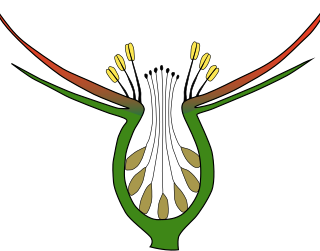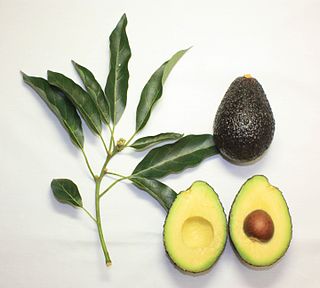Related Research Articles

In botany, a fruit is the seed-bearing structure in flowering plants (angiosperms) that is formed from the ovary after flowering.

The pineapple is a tropical plant with an edible fruit; it is the most economically significant plant in the family Bromeliaceae.

In botany, a drupe is a type of fruit in which an outer fleshy part surrounds a single shell of hardened endocarp with a seed (kernel) inside. Drupes do not split open to release the seed, i.e., they are indehiscent. These fruits usually develop from a single carpel, and mostly from flowers with superior ovaries.

An accessory fruit is a fruit that contains tissue derived from plant parts other than the ovary. In other words, the flesh of the fruit develops not from the floral ovary, but from some adjacent tissue exterior to the carpel. As a general rule, the accessory fruit is a combination of several floral organs, including the ovary. In contrast, true fruit forms exclusively from the ovary of the flower.

An achene, also sometimes called akene and occasionally achenium or achenocarp, is a type of simple dry fruit produced by many species of flowering plants. Achenes are monocarpellate and indehiscent. Achenes contain a single seed that nearly fills the pericarp, but does not adhere to it. In many species, what is called the "seed" is an achene, a fruit containing the seed. The seed-like appearance is owed to the hardening of the fruit wall (pericarp), which encloses the solitary seed so closely as to seem like a seed coat.

The jackfruit is a species of tree in the fig, mulberry, and breadfruit family (Moraceae). The jackfruit is the largest tree fruit, reaching as much as 55 kg in weight, 90 cm in length, and 50 cm in diameter. A mature jackfruit tree produces some 200 fruits per year, with older trees bearing up to 500 fruits in a year. The jackfruit is a multiple fruit composed of hundreds to thousands of individual flowers, and the fleshy petals of the unripe fruit are eaten.

Fruit wines are fermented alcoholic beverages made from a variety of base ingredients ; they may also have additional flavors taken from fruits, flowers, and herbs. This definition is sometimes broadened to include any alcoholic fermented beverage except beer. For historical reasons, mead, cider, and perry are also excluded from the definition of fruit wine.

Monstera deliciosa, the Swiss cheese plant or split-leaf philodendron is a species of flowering plant native to tropical forests of southern Mexico, south to Panama. It has been introduced to many tropical areas, and has become a mildly invasive species in Hawaii, Seychelles, Ascension Island and the Society Islands. It is very widely grown in temperate zones as a houseplant.
Horilka is a Ukrainian alcoholic beverage.

Starburst is the brand name of a box-shaped, fruit-flavoured soft taffy candy manufactured by The Wrigley Company, which is a subsidiary of Mars, Incorporated. Starburst has many different varieties, such as Tropical, Sour, FaveREDs, Watermelon, Very Berry, Superfruit, Summer Blast and Original.

Fruit salad is a dish consisting of various kinds of fruit, sometimes served in a liquid, either their juices or a syrup. In different forms, fruit salad can be served as an appetizer or a side as a salad. A fruit salad is sometimes known as a fruit cocktail, or fruit cup.

Syconium is the type of fruit borne by figs, formed by an enlarged, fleshy, hollow receptacle with multiple ovaries on the inside surface. In essence, it is really a fleshy stem with a number of flowers, so it is considered both a multiple and accessory fruit.

Multi-fruits, also called collective fruits, are fruiting bodies formed from a cluster of flowers, the inflorescence. Each flower in the inflorescence produces a fruit, but these mature into a single mass. After flowering, the mass is called an infructescence. Examples are the fig, pineapple, mulberry, osage orange, and jackfruit.

In the flowering plants, an ovary is a part of the female reproductive organ of the flower or gynoecium. Specifically, it is the part of the pistil which holds the ovule(s) and is located above or below or at the point of connection with the base of the petals and sepals. The pistil may be made up of one carpel or of several fused carpels, and therefore the ovary can contain part of one carpel or parts of several fused carpels. Above the ovary is the style and the stigma, which is where the pollen lands and germinates to grow down through the style to the ovary, and, for each individual pollen grain, to fertilize one individual ovule. Some wind pollinated flowers have much reduced and modified ovaries.

In botany, a berry is a fleshy fruit without a stone (pit) produced from a single flower containing one ovary. Berries so defined include grapes, currants, and tomatoes, as well as cucumbers, eggplants (aubergines), persimmons and bananas, but exclude certain fruits that meet the culinary definition of berries, such as strawberries and raspberries. The berry is the most common type of fleshy fruit in which the entire outer layer of the ovary wall ripens into a potentially edible "pericarp". Berries may be formed from one or more carpels from the same flower. The seeds are usually embedded in the fleshy interior of the ovary, but there are some non-fleshy exceptions, such as Capsicum species, with air rather than pulp around their seeds.

Caulophyllum thalictroides, the blue cohosh, is a species of flowering plant in the Berberidaceae (barberry) family. It is a medium-tall perennial with blue berry-like fruits and bluish-green foliage. The common name cohosh is probably from an Algonquian word meaning "rough". The Greek-derived genus name Caulophyllum signifies "stem-leaf", while the specific name thalictroides references the similarity between the large highly divided, multiple-compound leaves of meadow-rues and those of blue cohosh.

Fruits are the mature ovary or ovaries of one or more flowers. They are found in three main anatomical categories: aggregate fruits, multiple fruits, and simple fruits.
This glossary of botanical terms is a list of definitions of terms and concepts relevant to botany and plants in general. Terms of plant morphology are included here as well as at the more specific Glossary of plant morphology and Glossary of leaf morphology. For other related terms, see Glossary of phytopathology, Glossary of lichen terms, and List of Latin and Greek words commonly used in systematic names.

Ananas macrodontes is a plant species closely related to the pineapple, in the family Bromeliaceae. Its common name is the false pineapple, a name shared with the not closely related Pandanus kaida. There is no consensus whether this species should belong in the same genus as the pineapple (Ananas), or in its own genus (Pseudananas).

In botany, fleshy fruits are fruits which are fleshy and brightly coloured, making them attractive to animals which eat them and disperse the seeds. The word 'succulent fruit' is synonymous to fleshy fruit and both words are often used interchangeably.
References
- ↑ "infructescence", The Free Dictionary, retrieved 2022-03-18
- ↑ "Multiple Fruits, Pineapple Multiple Fruit, Examples of Multiple Fruits, Types of Multiple Fruits". www.fruitsinfo.com. Retrieved 2022-03-18.
- ↑ "Multiple Fruits". science.jburroughs.org. Archived from the original on 2022-01-08. Retrieved 2022-03-18.
- ↑ "Definition of SYCONIUM". www.merriam-webster.com. Retrieved 2022-03-18.



